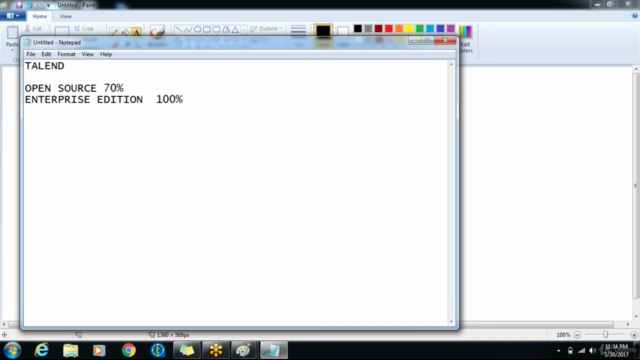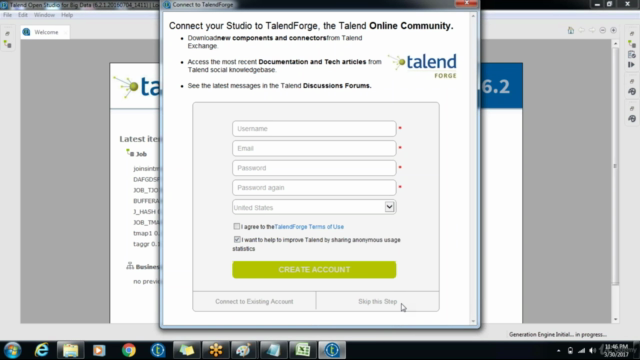Talend Open studio ,database ,warehouse course by mahesh

Why take this course?
It appears you've listed a comprehensive set of data integration components from the Apache NiFi ecosystem, specifically those provided by the tunite processor family. Apache NiFi is an open-source data integration and data flow automation tool developed by the Apache Software Foundation. It allows for the procurement, transformation, routing, and dissemination of data within a data flow.
Here's a brief explanation of some of the components you've mentioned:
-
tunite: This processor is a generic template to create new processors by extending its functionalities. It can be used to define custom processors for specific tasks that are not covered by the existing processors.
-
tuniqerow: This processor allows you to add, update, or delete a row in a relational database without the need to load all the data into memory.
-
tbufferinput/output: These processors provide an easy way to buffer incoming flowfile data for later processing or to output buffered data from previous processing steps.
-
thashinput/output: These processors allow you to perform hashing operations on input data (like MD5, SHA1, etc.) and to generate hashed values in the output flowfile attributes.
-
tfilelist: This processor can dynamically generate a list of files based on a variety of criteria, and then use that list in a flow.
-
tsleep: It allows you to introduce a delay or pause in the data flow for a specified duration.
-
tloop: This processor is used to perform operations in a loop a specified number of times or until a condition is met.
-
file input/output components: These processors are used to handle file operations like reading from, writing to, creating, moving, deleting files, etc.
-
database input/output components: These processors facilitate the interaction with databases, allowing for SQL queries, CRUD (Create, Read, Update, Delete) operations, and more.
-
tsendmail: This processor sends emails as part of a data flow, allowing for integration with email systems.
-
treplicate: It replicates flowfiles to one or more destinations, which is useful for implementing data redundancy.
-
tfiltercolumns/tfilterrows: These processors are used to select specific columns or rows from the incoming data based on certain criteria.
-
treplace: This processor replaces specified values or substrings within a flowfile's content or attributes.
-
tconverttype: It converts the content type of the flowfile to another format, such as text to binary or vice versa.
-
tdie: This processor is used to stop processing a flowfile and make it available for subsequent processors to handle (like moving it to a queue).
-
tcontextload/tmemorizerow/trunjob/prejob/postjob: These processors are related to the context service in NiFi, which allows for stateful processing by storing and retrieving attributes across multiple processors or flows.
-
runif: This is a reference to RUNIFLAW, a widely-used standard content bundle for Apache NiFi that contains sample flow templates, processors, and utilities to get started with NiFi quickly.
The remaining entries seem to be specific to your project's needs or internal process names, such as "SCD1/SCD2" which typically refer to Slowly Changing Dimension types 1 and 2 used in data warehousing for handling changes in dimensional data over time.
Apache NiFi's flexibility and extensibility make it a powerful tool for a wide range of data integration tasks, from simple to complex, within an organization or as part of a larger system.
Course Gallery




Loading charts...
Comidoc Review
Our Verdict
The Talend Open Studio: Database, Warehouse Course by Mahesh proves to be a valuable resource for beginners and experienced professionals alike seeking in-depth knowledge on the subject. Despite minor drawbacks such as background noises, inconsistent pacing, and occasional unkept promises regarding captions, the course offers valuable real-world problem-solving insights that significantly contribute to hands-on learning among students. A strong recommendation for ETL enthusiasts looking to upskill in Talend Open Studio within data integration, administration, and Bigdata.
What We Liked
- Comprehensive coverage of Talend Open Studio, data integration, admin, and Bigdata
- In-depth knowledge provided with solid hands-on sessions & access to software & notes
- Real-world issues & scenarios discussed, addressing practical applications of ETL processes
- Responsive instructor accessible for queries on the course forum
Potential Drawbacks
- Background noises present in some video lessons
- Lack of subtitles or English captions affects clarity of instructions
- Limited demonstrations available on latest Talend Studio versions (7.X)
- Pacing issues with lessons, some extending longer causing disorder; infrequent breaks